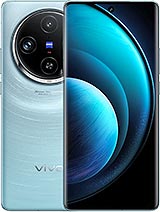OnePlus 12 review

Android 14 with ColorOS 14 OxygenOS 14 on top
The OnePlus 12 runs on Android 14 with a layer of OxygenOS. You can expect 4 major OS upgrades and 5 years of security patches, so the software future is reasonably well covered, if not quite the 7 years we've been hearing from Google and Samsung.
The Oxygen name may evoke memories of OnePlus' distinct character and personality, but now it's little more than just another label for what is essentially the same thing. Indeed, whether it's RealmeUI, OxygenOS, or ColorOS itself, the look, feel, and experience is largely identical.

Okay, that's not entirely true - there are custom clock faces for the Always-on display with signature red accents, and there's a OnePlus Sans font (which is not too different from the Realme Sans, just saying).
Customizability is a common theme across all of OxygenOS. There is an entire Wallpapers & style page in Settings, where in addition to the AoD settings, you can change wallpapers (live and static), switch to different icon packs, different quick toggles icon shapes, change, and choose completely different colors that will change the entire UI look. You can turn on/off Edge Lighting, which is independent of the Always-On Display. Dark Mode is available, and it offers three different shades of darkness.
The launcher comes with no-nonsense homescreens, a straightforward and clean notification/toggles area, and an easy-to-use task switcher. An optional App drawer is available, too, and it is as clutter-free as one could hope for. Quick Glance is the leftmost widget pane here instead of Google Discover. Support for Large Folders is also included.






OxygenOS: Lockscreen • Homescreen • Notifications • Quick toggles • App switcher • Large folders
Circling back to the customizeability theme, there are many powerful tools within the settings menu if you want full control over your experience. The features are wide-ranging but generally carried over from previous ColorOS versions. A host of screen-on and screen-off gestures are available; the Smart Sidebar is a handy pane of shortcuts you pull from the side, and split-screen and Flexible windows are available.
There are a few in-house apps, too, other than the ton of China-specific bloatware. Photos, a revamped File Manager, and an in-house web browser (who would ever?) are part of the package. An IR Remote app is also available, so you can make use of the newly-introduced IR blaster right out of the box.





Photos • File Manager • Web Browser • Weather • IR remote
Finally, there is also a dedicated Games center with a special performance mode, game toolkit, and granular game management. There's a Championship mode too, if you're really serious about your gaming.
Benchmarks and performance
The OnePlus 12 is powered by the Snapdragon 8 Gen 3, Qualcomm's top-tier chipset that most 2024 flagships will use. It's not the first time we're seeing it perform, with the iQOO 12 and the the Realme GT5 already setting some records.
The phone is available in several memory configurations, though the international version will only come in 12GB/256GB and 16GB/512GB versions (our review unit is the latter). The Chinese market will also get 1TB of storage with either 16GB or 24GB of RAM. Either way, RAM is LPDDR5X and the storage is UFS 4.0.

ColorOS and its derivatives have been known to feature a High Performance mode in the battery settings, which normally allows the CPU to run at its full potential with higher thermal thresholds and little consideration for battery efficiency. That affects mostly single-core loads on the prime core (GeekBench) and in turn the overall score in compound benchmarks (Antutu). The GPU isn't usually affected by this setting, and it's always working at full power, though unleashing the CPU can add an extra frame or two per second to the GPU scores.
While that's a known peculiarity when it comes to phones from these brands, the OnePlus 12 in particular behaved unusually in that it posted noticeably lower benchmark scores than what the hardware is capable of. That was especially noticeable in CPU-centric tests and in Antutu where the CPU has a significant impact.
GPU benchmarks scores were more in line with what we'd expect. Then again, in that case the OP12 is hampered by ColorOS' refusal to allow GFXBench to run at anything past 60fps in onscreen benchmarks, so only the offscreen numbers can be used for any indication of performance.
Since we're testing the OnePlus 12 before its official release to the public, we can't eliminate the possibility that OnePlus has tinkered with the phone's behavior to alter its performance. We'll keep an eye out for updates in the coming days, and update these results as needed.
Update, 16 Dec 2024: We got the opportunity to briefly test another OnePlus 12 unit and it scored notably higher in GeekBench and Antutu - in line with other devices with the same chipset. Oddly enough, we got ever so slightly lower numbers in the GPU tests. We're updated the charts with the new numbers, leaving the old ones for comparison.
When it comes to sustained load handling, OnePlus has engineered a dual vapor chamber with a total area of 9,140sq.mm. It's no miracle worker, but the OP12 does manage to put out decent numbers in stress tests. It's about on par with the Realme GT5 Pro, but not as good as the iQOO 12 in the CPU Throttle test (all three being SD 8 Gen 3 devices). The Dimensity-powered vivo X100 Pro is also ahead of the OnePlus in terms of stability under prolonged CPU load.
In the GPU department, we're used to seeing numbers around the 55% mark from flagships in the 3DMark Wild Life stress test and that's what we got from the OnePlus 12 as well.
Reader comments
- Ameer
- 04 Mar 2025
- uu2
Benchmarks have been updated on 16th dec 2024 but does this apply to the stress test? did the stability score change?
- Hopping Kingfisher
- 06 Jan 2025
- 7Wj
Same as Samsung green line issues
- Malik
- 30 Dec 2024
- UUK
Green line issues




































